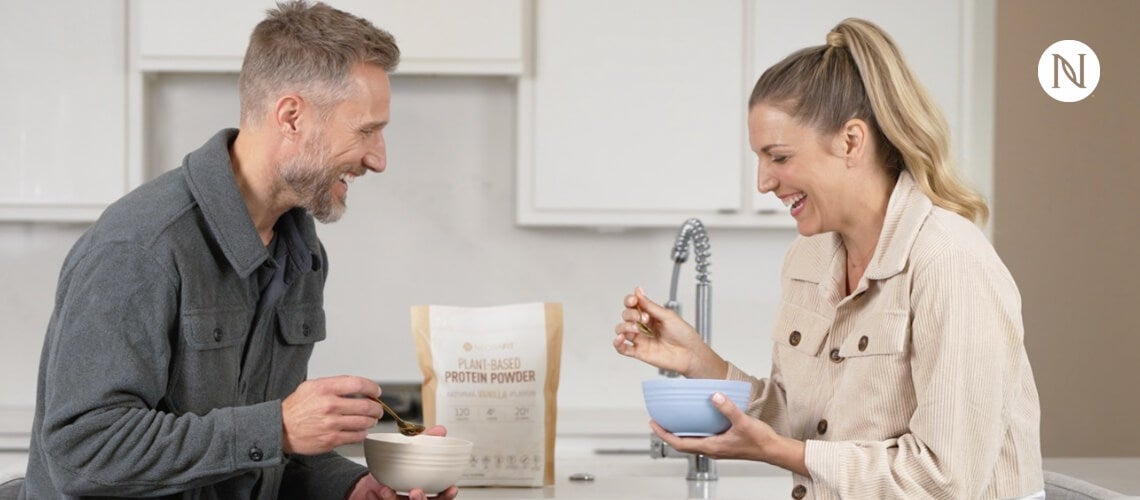Tip Sheet: 5 Ways to Add Healthy Carbs to Your Diet

Carbs get a bad rap, but they really shouldn’t! Carbohydrates are one of the three major macronutrients our bodies need to function at its peak. USDA dietary guidelines recommend that carbs make up 45-65% of our total daily calorie intake. But remember, there are ‘good’ carbs, and then there are the ‘bad’ carbs. Make sure that you are consuming the good ones for a healthy diet.
Start your off day right with a piping hot bowl of oatmeal
Oatmeal is a great way to start the day off. Oatmeal provides you with lots of energy and helps replenish glycogen stores first thing in the morning so that you are fueled for the entire day. Whether you cook it on the stovetop or prep it the night before as overnight oats, this whole grain is an excellent source of complex carbohydrates and easily combines with other super healthy foods like fresh fruit, nuts, and seeds.
Build your snacks around carbs for maximum energy
A healthy snack should clock in at around 200-300 calories depending on your age, weight, and activity level. I encourage my clients to assemble snacks with staying power by pairing a protein with a nutritious carbohydrate source. Some examples of this include:
- Hummus with sliced carrots and cucumber
- Cheese and whole grain crackers
- Peanut butter and apple
- Low-fat Greek yogurt, fresh berries, and a sprinkle of sliced almonds
- My favorite smoothie made with frozen banana, mango, spinach, unsweetened almond milk, and scoop of NeoraFit Plant-Based Protein Powder.
Take your lunchtime salads up a notch
Say goodbye to boring desk salads of lettuce and ranch dressing, and say hello to balanced, filling and nourishing salads. Start with a leafy green base using greens such as arugula, romaine, or kale and pile on your favorite mixed vegetables like tomatoes, cucumbers, and carrots, adding in a half-cup serving of whole grains like cooked quinoa or brown rice or pasta, and topping off with a half-cup serving of cooked legumes such as lentils or chickpeas. Not only do whole grains and legumes give your salad more staying power, but they also add energizing carbohydrates to help you power through your afternoon.
Balance your dinner plate
Simply following the plate method at dinner will help ensure that you get in those nutritious carbohydrates. The plate method encourages filling half your plate with non-starchy vegetables such as leafy greens, broccoli, cucumber and zucchini, one-fourth of your plate with lean protein like chicken or fish, and the remaining one-fourth with fiber-rich carbohydrates such as whole grain pasta, brown rice, farro or any other starchy veggies such as sweet potato or green peas.
Rethink dessert
Carbs are often synonymous with desserts and are touted as bad for you, but you don’t have to completely forgo your sweet tooth if you build your own desserts using nutritious sources of carbohydrates. Some sweet ideas that satisfy cravings using good carbs are:
- Raspberries stuffed with dark chocolate chips
- A Medjool date dipped in peanut butter
- Homemade “ice cream” made by blending a frozen banana with almond milk
- Oatmeal banana cookies made with ½ cup of quick oats, 1 large, mashed banana and mini dark chocolate chips baked for 10-12 minutes at 350 F
For more ideas on sweets and snacks that combine protein with good carbs makes sure to visit Neora’s Blog.
Hopefully by now you have realized that not all carbs are evil. Carbohydrates are important for not only energy production but also for weight management, digestion, gut health, blood sugar regulation, and so much more. Focusing on nutrient-dense complex carbohydrates like whole grains, fruit, vegetables, dairy, and beans, and limiting nutrient-poor sources such as refined grains and sugar-sweetened beverages and desserts, can help ensure that you meet your nutritional needs and support healthy aging.
No Comments